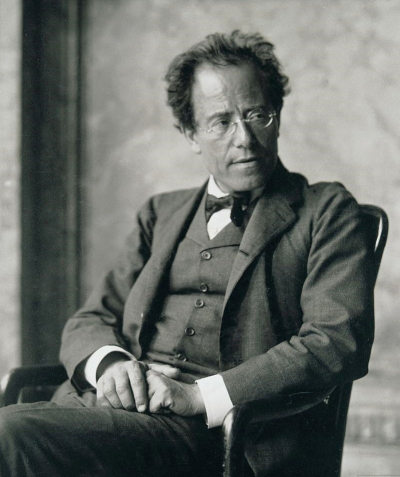The Symphony No. 8 in E-flat major by Gustav Mahler is one of the largest-scale choral works in the classical concert repertoire. As it requires huge instrumental and vocal forces it is frequently called the "Symphony of a Thousand", although the work is normally presented with far fewer than a thousand performers and the composer did not sanction that name actually, he disapproved of it. The work was composed in a single inspired burst at his Maiernigg villa in southern Austria in the summer of 1906. The last of Mahler's works that was premiered in his lifetime, the symphony was a critical and popular success when he conducted the Munich Philharmonic in its first performance, in Munich, on 12 September 1910.
The fusion of song and symphony had been a characteristic of Mahler's early works. In his "middle" compositional period after 1901, a change of style led him to produce three purely instrumental symphonies. The Eighth, marking the end of the middle period, returns to a combination of orchestra and voice in a symphonic context. The structure of the work is unconventional: instead of the normal framework of several movements, the piece is in two parts ("1." and "2. Teil"). Part I is based on the Latin text of Veni creator spiritus ("Come, Creator Spirit"), a ninth-century Christian hymn for Pentecost, and Part II is a setting of the words from the closing scene of Goethe's Faust. The two parts are unified by a common idea, that of redemption through the power of love, a unity conveyed through shared musical themes.
Mahler had been convinced from the start of the work's significance; in renouncing the pessimism that had marked much of his music, he offered the Eighth as an expression of confidence in the eternal human spirit. In the period following the composer's death, performances were comparatively rare. However, from the mid-20th century onwards the symphony has been heard regularly in concert halls all over the world, and has been recorded many times. While recognising its wide popularity, modern critics have divided opinions on the work; Theodor W. Adorno, Robert Simpson, and Jonathan Carr found its optimism unconvincing, and considered it artistically and musically inferior to Mahler's other symphonies. Conversely, it has been compared by Deryck Cooke to Ludwig van Beethoven's Symphony No. 9 as a defining human statement for its century.
Gustav Mahler (German: [ˈmaːlɐ]; 7 July 1860 – 18 May 1911) was an Austro-Bohemian Romantic composer, and one of the leading conductors of his generation. As a composer he acted as a bridge between the 19th-century Austro-German tradition and the modernism of the early 20th century. While in his lifetime his status as a conductor was established beyond question, his own music gained wide popularity only after periods of relative neglect, which included a ban on its performance in much of Europe during the Nazi era. After 1945 his compositions were rediscovered by a new generation of listeners; Mahler then became one of the most frequently performed and recorded of all composers, a position he has sustained into the 21st century. In 2016, a BBC Music Magazine survey of 151 conductors ranked three of his symphonies in the top ten symphonies of all time.Born in Bohemia (then part of the Austrian Empire) to Jewish parents of humble origins, the German-speaking Mahler displayed his musical gifts at an early age. After graduating from the Vienna Conservatory in 1878, he held a succession of conducting posts of rising importance in the opera houses of Europe, culminating in his appointment in 1897 as director of the Vienna Court Opera (Hofoper). During his ten years in Vienna, Mahler—who had converted to Catholicism to secure the post—experienced regular opposition and hostility from the anti-Semitic press. Nevertheless, his innovative productions and insistence on the highest performance standards ensured his reputation as one of the greatest of opera conductors, particularly as an interpreter of the stage works of Wagner, Mozart, and Tchaikovsky. Late in his life he was briefly director of New York's Metropolitan Opera and the New York Philharmonic.
Mahler's œuvre is relatively limited; for much of his life composing was necessarily a part-time activity while he earned his living as a conductor. Aside from early works such as a movement from a piano quartet composed when he was a student in Vienna, Mahler's works are generally designed for large orchestral forces, symphonic choruses and operatic soloists. These works were frequently controversial when first performed, and several were slow to receive critical and popular approval; exceptions included his Second Symphony, and the triumphant premiere of his Eighth Symphony in 1910. Some of Mahler's immediate musical successors included the composers of the Second Viennese School, notably Arnold Schoenberg, Alban Berg and Anton Webern. Dmitri Shostakovich and Benjamin Britten are among later 20th-century composers who admired and were influenced by Mahler. The International Gustav Mahler Institute was established in 1955 to honour the composer's life and achievements.

1910Sep, 12
Premiere performance of Gustav Mahler's Symphony No. 8 in Munich (with a chorus of 852 singers and an orchestra of 171 players. Mahler's rehearsal assistant conductor was Bruno Walter)
Choose Another Date
Events on 1910
- 11May
Glacier National Park (U.S.)
An act of the U.S. Congress establishes Glacier National Park in Montana. - 4Jul
Jack Johnson (boxer)
African-American boxer Jack Johnson knocks out white boxer Jim Jeffries in a heavyweight boxing match, sparking race riots across the United States. - 15Jul
Alzheimer's disease
In his book Clinical Psychiatry, Emil Kraepelin gives a name to Alzheimer's disease, naming it after his colleague Alois Alzheimer. - 18Sep
Suffrage
In Amsterdam, 25,000 demonstrate for general suffrage. - 7Nov
Wright brothers
The first air freight shipment (from Dayton, Ohio, to Columbus, Ohio) is undertaken by the Wright brothers and department store owner Max Moorehouse.

 English
English  español
español  français
français  português
português  русский
русский  العربية
العربية  简体中文
简体中文 